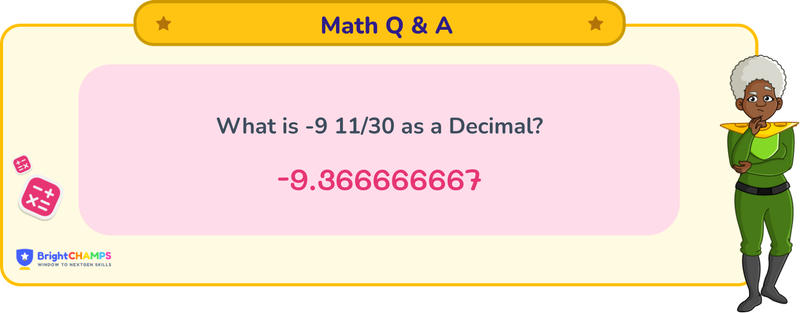
 145 Learners
145 LearnersLast updated on May 26th, 2025

-9 11/30 as a Decimal

It is a simple question on decimal conversion. Firstly, we have to learn fractions and decimals. A fraction represents a part from the whole. It has two parts, numerator (number on the top) here, 11 represents how many parts out of the whole. The denominator (number below) shows how many parts make the whole, here it is 30. A decimal is a way to represent the number that is not whole, using a (.) or a decimal to separate the whole part from the fraction part. The numbers to the left of the decimal point represent the whole, and that to the right represents the fractional part.
What is -9 11/30 as a decimal?

Answer
-9 11/30 in decimals can be written as -9.3666…. It is a recurring decimal, showing it will repeat a sequence of digits infinitely.
Explanation
To get -9 11/30 in decimal, we will use the division method for the fractional part and add it to the whole number. Let's see the step-by-step breakdown of the process:
Step 1: Identify the whole number and the fractional part. Here, the whole number is -9, and the fraction is 11/30.
Step 2: Convert the fraction 11/30 to a decimal by dividing 11 by 30.
Step 3: Since 11 is smaller than 30, we will use the decimal method. Add a decimal point and a zero to 11, making it 110.
Step 4: Divide 110 by 30. 30 goes into 110 three times (30 × 3 = 90), leaving a remainder of 20.
Step 5: Bring down another 0, making it 200, and divide by 30 again. 30 goes into 200 six times (30 × 6 = 180), leaving a remainder of 20.
Step 6: Repeat the process, bringing down zeros, and you will see the division results in a recurring decimal: 0.3666...
Step 7: Combine the whole number with the decimal part: -9 + 0.3666... = -9.3666...
The answer for -9 11/30 as a decimal is -9.3666….
Struggling with Math?
Get 1:1 Coaching to Boost Grades Fast !

Important Glossaries for -9 11/30 as a decimal
- Fraction: A numerical quantity that is not a whole number, representing a part of a whole.
- Decimal: A number that uses the base ten and includes a decimal point to separate the whole part from the fractional part.
- Numerator: The top part of a fraction, indicating how many parts of the whole are being considered.
- Denominator: The bottom part of a fraction, showing how many parts make up a whole.
- Recurring Decimal: A decimal in which a sequence of digits repeats infinitely.




